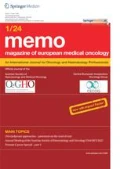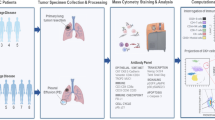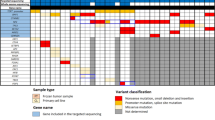Summary
Both NSCLC and MPM are composed of different histotypes. These histotypes are clinically relevant, since both mutational profiles and response to chemotherapeutic drugs are different. Next to histotype markers, predictors such as EGFR are increasingly required in clinical pathology, also on cell blocks from pleural effusions. Such effusions can arise from both lung adenocarcinoma and MPM, thus are a valid resource for new biomarkers. We identified the epithelial-mesenchymal transition N-glycoprotein periostin in effusions from lung AC by shotgun mass spectrometry. EMT is an important transdifferentiation concept, whereby polarized epithelial cells detach from their solid lattice and become migratory and invasive via acquisition of a fibroblastoid phenotype. The EMT programme is regulated by a complex signalling network, leading to an upregulation of mesenchymal proteins like vimentin, associated with loss of E-cadherin. The EMT protein periostin was correlated with clinico-pathological parameters of tumour progression, the squamous cell histotype of NSCLC and the sarcomatoid of MPM, respectively. Importantly, EMT is related to the cancer stem cell phenotype, conferring increased drug resistance. Both NSCLC and MPM tumour cells are embedded in a prominent desmoplastic stroma. A microenvironment therapy could comprise a combination of inhibitors directed against tumour cell surface receptors, neo-vessels, extracellular matrix fibres and immune cells. Derivatives of the human monoclonal scFv antibodies L19 and F16, specific to the splice isoforms of fibronectin (with extracellular domain B) and tenascin-C (Al domain) are clinically effective, thus intracavitary chemotherapy with pleural infusion is a phase 1/2 study rationale for advanced lung AC or MPM.
Similar content being viewed by others
References
Kerr KM. Pulmonary adenocarcinomas: classification and reporting. Histopathology, 2009; 54: 12–27
Motoi N, Szoke J, Riely GJ, et al. Lung adenocarcinoma: modification of the 2004 WHO mixed subtype to include the major histologic subtype suggests correlations between papillary and micropapillary adenocarcinoma subtypes, EGFR mutations and gene expression analysis. Am J Surg Pathol, 2008; 32: 810–827
Gridelli C, Ardizzoni A, Douillard JY, et al. Recent issues in first-line treatment of advanced non-small-cell lung cancer: Results of an International Expert Panel Meeting of the Italian Association of Thoracic Oncology. Lung Cancer, 2010; 68: 319–331
Sharma SV, Bell DW, Settleman J, et al. Epidermal growth factor receptor mutations in lung cancer. Nat Rev Cancer, 2007; 7: 169–181
Mok TS, Wu YL, Thongprasert S, et al. Gefitinib or carboplatin-paclitaxel in pulmonary adenocarcinoma. N Engl J Med, 2009; 361: 947–957
Olaussen KA, Dunant A, Fouret P, et al. DNA repair by ERCC1 in non-small-cell lung cancer and cisplatin-based adjuvant chemotherapy. N Engl J Med, 2006; 355: 983–991
Perner S, Wagner PL, Demichelis F, et al. EML4-ALK fusion lung cancer: a rare acquired event. Neoplasia, 2008; 10: 298–302
Soltermann A, Ossola R, Kilgus-Hawelski S, et al. N-glycoprotein profiling of lung adenocarcinoma pleural effusions by shotgun proteomics. Cancer, 2008; 114: 124–133
Yan W, Shao R. Transduction of a mesenchyme-specific gene periostin into 293T cells induces cell invasive activity through epithelial-mesenchymal transformation. J Biol Chem, 2006; 281: 19700–19708
Bhowmick NA, Neilson EG, Moses HL. Stromal fibroblasts in cancer initiation and progression. Nature, 2004; 432: 332–337
Hofmeister V, Schrama D, Becker JC. Anti-cancer therapies targeting the tumor stroma. Cancer Immunol Immunother. 2008; 57: 1–17
Thiery JP. Epithelial-mesenchymal transitions in tumour progression. Nat Rev Cancer, 2002; 2: 442–454
Kang Y, Massague J. Epithelial-mesenchymal transitions: twist in development and metastasis, Cell, 2004; l 18: 277–279
Mimeault M, Batra SK. Interplay of distinct growth factors during epithelial mesenchymal transition of cancer progenitor cells and molecular targeting as novel cancer therapies. Ann Oncol, 2007; 18: 1605–1619
Kuhn B, del Monte F, Hajjar RJ, et al. Periostin induces proliferation of differentiated cardiomyocytes and promotes cardiac repair. Nat Med, 2007; 13: 962–969
Polyak K, Weinberg RA. Transitions between epithelial and mesenchymal states: acquisition of malignant and stem cell traits. Nat Rev Cancer, 2009; 9: 265–273
Mani SA, Guo W, Liao MJ, et al. The epithelial-mesenchymal transition generates cells with properties of stem cells. Cell, 2008; 133: 704–15
Singh A, Settleman J. EMT, cancer stem cells and drug resistance: an emerging axis of evil in the war on cancer. Oncogene, 2010; Jun 7, Epub
Soltermann A, Tischler V, Arbogast S, et al. Prognostic significance of epithelial- mesenchymal and mesenchymal-epithelial transition protein expression in non-small cell lung cancer. Clin Cancer Res, 2008; 14: 7430–7437
Prudkin L, Liu DD, Ozburn NC, et al. Epithelial-to-mesenchymal transition in the development and progression of adenocarcinoma and squamous cell carcinoma of the lung. Mod Pathol, 2009; 22: 668–678
Garber K. Epithelial-to-mesenchymal transition is important to metastasis, but questions remain. J Natl Cancer Inst, 2008; 100: 232–233, 239
Opitz I, Soltermann A, Abaecherli M, et al. PTEN expression is a strong predictor of survival in mesothelioma patients. Eur J Cardiothorac Surg, 2008; 33: 502–506
Schramm A, Opitz I, Thies S, et al. Prognostic significance of epithelial-mesenchymal transition in malignant pleural mesothelioma. Eur J Cardiothorac Surg, 2010; 37: 566–572
Rybak IN, Trachsel E, Scheuermann J, et al. Ligand-based vascular targeting of disease. Chem Med Chem, 2007; 2: 22–40
Sauer S, Erba PA, Petrini M, et al. Expression of the oncofetal ED-B-containing fibronectin isoform in hematologic tumors enables ED-B-targeted 131I-L19SIP radioimmunotherapy in Hodgkin lymphoma patients. Blood, 2009; 113: 2265–2274
Pedretti M, Soltermann A, Ami S, et al. Comparative immunohistochemistry of L19 and F16 in non-small cell lung cancer and mesothelioma: two human antibodies investigated in clinical trials in patients with cancer. Lung Cancer, 2009; 64: 28–33
Castronovo V, Waltregny D, Kischel P, et al. A chemical proteomics approach for the identification of accessible antigens expressed in human kidney cancer. Mol Cell Proteomics, 2006; 5: 2083–2091
Hoersch S, Andrade-Navarro MA. Periostin shows increased evolutionary plasticity in its alternatively spliced region. BMC Evol Biol, 2010; 10: 30
Kim CJ, Isono T, Tambe Y, et al. Role of alternative splicing of periostin in human bladder carcinogenesis. Int J Oncol, 2008; 32: 161–169
Author information
Authors and Affiliations
Corresponding author
Rights and permissions
About this article
Cite this article
Soltermann, A., Opitz, I., Tischler, V. et al. EMT in NSCLC and malignant pleural mesothelioma. memo 3, 180–184 (2010). https://doi.org/10.1007/s12254-010-0227-2
Received:
Accepted:
Published:
Issue Date:
DOI: https://doi.org/10.1007/s12254-010-0227-2




